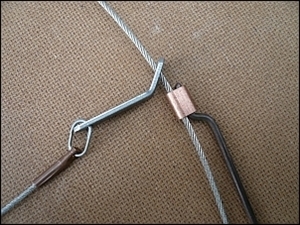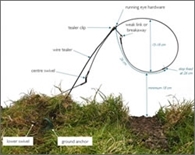Summary
 Effective fox control is an integral part of wildlife management, for conserving wild species of ground nesting birds and game birds. Snaring plays an important role in fox control in some circumstances. If snares are well designed and used strictly according to the Defra Code of Practice, they surpass international standards for restraining traps. Fox snares do, nonetheless, have attendant risks of poor welfare and non-target capture. Therefore, the GWCT considers it essential that fox snare operators always use them responsibly.
Effective fox control is an integral part of wildlife management, for conserving wild species of ground nesting birds and game birds. Snaring plays an important role in fox control in some circumstances. If snares are well designed and used strictly according to the Defra Code of Practice, they surpass international standards for restraining traps. Fox snares do, nonetheless, have attendant risks of poor welfare and non-target capture. Therefore, the GWCT considers it essential that fox snare operators always use them responsibly.
The GWCT has undertaken substantial research to identify how snaring can be improved through better operating practices, training and snare design. We are strongly committed to ensuring such improvements take place.
Background
Fox control is a widespread and, many would argue, necessary part of managing wildlife in rural Britain. Foxes kill young lambs, piglets reared outdoors, and free range and domestic poultry. Farmers cull foxes when experience shows there is a risk of predation on livestock or when predation is already taking place. Foxes also prey on vulnerable wild ground-nesting birds like black grouse, partridge, lapwing, curlew and stone curlew, and on brown hare. Several of these are species of conservation concern, others are game species; some are both. In order to protect vulnerable species while they are breeding, gamekeepers control foxes mainly from late winter to early summer. Foxes are also controlled around pheasant and partridge rearing and release pens in late summer and autumn.
There are several methods to control foxes but none of them are effective in all circumstances. One method widely used for foxes is snaring. Snares are particularly effective for foxes in places and at times of the year when rifle shooting is not possible because of dense cover but when fox control may be critical for wild prey.
GWCT position
The Game & Wildlife Conservation Trust regards the fox snare as a uniquely effective tool that has no functional replacement in the effective control of fox predation. Fox snares do have attendant risks of poor welfare and non-target capture. Snares are designed to capture but not kill the animal. (Self-locking snares, which were designed to kill by strangulation, were banned in 1981). However, captured animals struggle and may be injured. Non-target animals such as badgers and hares are sometimes caught.
Therefore, the GWCT considers it essential that fox snare operators use them responsibly, preferring other methods of fox control when possible. The GWCT has undertaken substantial research to identify how snaring can be improved through operating practices and snare design. Our peer-reviewed research has shown that the performance of well designed snares used according to the Defra Code of Practice surpasses international standards for restraining traps.
GWCT recommendations
To ensure that the general use of snares comes up to this standard, we recommend:
- All snare users should make sure they are familiar with the latest Code of Practice (CoP) and training, and replace any snares they currently hold which do not conform with the CoP. If their snares kill or wound an animal they could be open to prosecution under the Animal Welfare Act (2006). If they have followed the recommendations of the CoP in good faith, they have a robust defence; otherwise they do not.
- Farmers’ organisations should promote the CoP to their members and encourage them to get trained. However, efforts should be made on all sides to deliver training to those who currently ‘slip through the net’ because they are not members of such organisations.
- Employers of gamekeepers should insist that their staff only purchase or make snares that meet the specification set out in the CoP, and that their working practices adhere to the CoP.
- Snare manufacturers should alter their current designs of snare so that they conform to the design specified in the CoP (including a built-in weak-point at the eye, stop set to allow a minimum noose of circumference 26cm). We hope that increasingly a breakaway shown to be effective in UK conditions will be incorporated into available models.
- The GWCT will continue to provide and promote training in the use of snares. Our training is based on evidence and long experience, and will advocate the highest standards of responsible and effective practice, not merely minimum compliance. Our experience-based recommendations have in fact changed little since the first publication of our advice leaflet in 1997, though the evidence to support them has accumulated.
- The evidence of this report supports the concept of accreditation following training, and of snare-tagging as a means of identifying the responsible user. We recognise the difficulties involved in implementing this level of regulation, and look forward to discussions about it with Defra and with other interest groups. We do not see any logical reasons why the statutory or CoP requirements in Scotland or Northern Ireland should be different from those in England and Wales.
Further information
The Game & Wildlife Conservation Trust has been actively researching the use and design of snares since 1992. It established the first training course in the use of fox snares and in 1997 published the first guidance on how to use them responsibly, including recommendations that went beyond legal requirements. The Trust took part in the Independent Working Group on Snares, convened by UFAW at the request of Defra, and made its research findings available for inclusion in the report.
Continuing concern about animal welfare led to an independent review of the use of snares1, the development of a code of practice2, and an action plan3 – all published in 2005. The independent review noted that there was very poor knowledge of the extent of use of snares in England and Wales and it recommended an investigation. In 2007 Defra commissioned the Food & Environment Research Agency (FERA) and the Game & Wildlife Conservation Trust (GWCT) to undertake a study into the use of snares for fox and rabbit control in England and Wales, as well as to assess how the new Code of Practice was working4.
A second study by GWCT of a further developed snare design showed that considerable improvements could be made to achieve a greater selectivity of capture5.
The Trust now promotes Defra’s Code of Practice in its training programmes. The Trust has recently developed and field-tested a new snare design which complies with and improves upon the design specified in the code. The new snare reduces welfare issues by allowing self-release of the vast majority of non-target captures, but is just as effective in fox control as conventional designs.
References
- (2005) Report of the Independent Working Group on Snares. Department of the Environment, Food and Rural Affairs, London.
- (2005) Defra Code of Good Practice on the use of Snares in Fox and Rabbit Control. Department of the Environment, Food and Rural Affairs, London.
- (2005) Defra Snares Action Plan. Department of the Environment, Food and Rural Affairs, London.
- (2012) Determining the Extent of Use and Humaneness of Snares in England and Wales. Report to Defra.
- Short, M.J., Weldon, A.W., Richardson, S.M., Reynolds, J.C. (2012) Selectivity and injury risk in an improved neck snare for live capture of foxes. Wildlife Society Bulletin 36(2): 208-219.
Get your FREE fox snaring guide from the GWCT team
Simply enter your email address below to download your essential free guide.
 What's inside your FREE fox snaring guide
What's inside your FREE fox snaring guide
✓ Fox control: Is it important?
✓ What are the alternatives to snaring?
✓ The main components of a well-designed snare
✓ Fox snares: Hardware vs practice
✓ Key controversies
Download free >